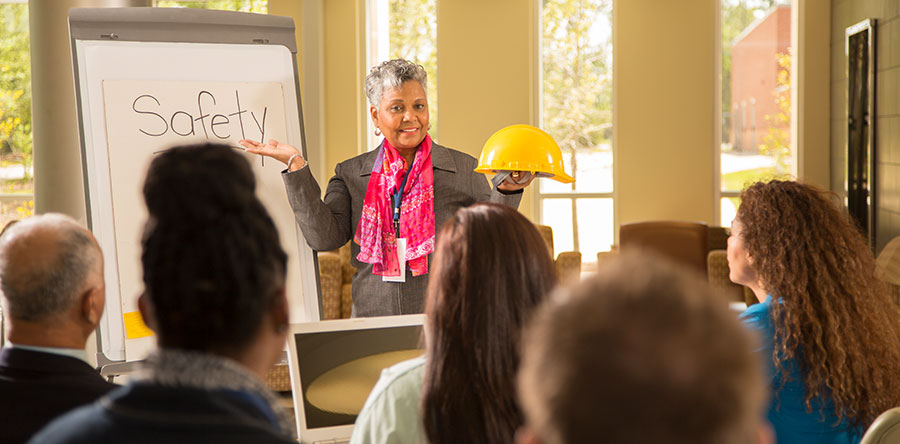The pandemic has changed our workplaces in numerous ways and many people are re-evaluating and assessing their level of satisfaction, and sense of security and safety at work. Many are choosing to change jobs or leave the workforce altogether. As a result, many workplaces are are facing higher turnover rates and labour shortages. To address this, employers are filling more positions with vulnerable workers.
Research shows that this segment of the workforce may be more exposed to injury and illness than other workers because of their lack of experience, reluctance to ask questions, communication barriers, and the type of work they do.
So what can you do as a leader to make sure all employees, and, in particular, vulnerable workers, feel psychologically safe and understand how to keep themselves, their co-workers, and your customers safe on the job?
Who are vulnerable workers?
The Law Commission of Ontario categorizes women, racialized persons, immigrants, Aboriginal persons, persons with disabilities, older adults, and youth as vulnerable workers.
Often, vulnerable workers fall into a lower socio-economic group because of race, ethnicity, sex, age, or immigration status. Their circumstances can make it more challenging to earn a respectable income, and they are more likely to work in unfavourable conditions, increasing their risk of physical or mental injury.
All workers deserve to be protected
It’s important to keep in mind that the term vulnerable worker refers to the worker, not the duties they perform. OHS legislation exists as a means of controlling bias that often jeopardizes the psychological and physical safety of this segement of the workforce. The legislation ensures that workers receive the same level of safety and protection whether they are picking crops or designing the equipment to plow fields.
Despite the legislation, there are still some inequities that threaten these workers. The federal government has raised the flag that vulnerable foreign workers are at higher risk of abuse. And statistics show that new workers between the ages of 15-24 are three times more likely to be injured on a job than experienced workers.
To counter this, the government has created a list of employers who have failed to comply with legislation as a means of guiding and protecting vulnerable workers.
Protecting the physical and psychological safety of vulnerable workers
Vulnerable workers should be trained and protected and understand all of their rights, including refusal of dangerous work, proper training in use of all equipment, provision of acceptable PPE, regular engagement in health and safety activities. Most importantly, they should feel safe to talk to their direct supervisor when they have concerns or hazards arise.
To ensure this, WSPS suggests you should:
- Establish procedures and measures for workplace health and safety and ensure they are always followed.
- Ensure equipment and personal protective equipment are provided and maintained properly.
- Ensure that all hazards, illnesses, and injuries are reported immediately.
- Identify workplace hazards and provide training and instruction for handling them.
- Provide proper and ongoing training.
- Respond promptly to all health and safety concerns.
- Lead by example: use and wear safety equipment when required and participate in drills and other emergency response training.
Here are some additional tips to help you protect vulnerable workers:
- Create a safe and inclusive culture through authenticity, openness, action and commitment to continuous improvement, and recognize that you must model the behaviour that you want to see in others.
- Train leaders to be psychologically safe leaders who operate through an inclusive lens and learn to manage implicit bias and blind spots.
- Treat every employee as an individual with unique needs.
- Don’t assume employees are fine just because they aren’t telling you anything. Check in with them. Do this for all workers and pay particular attention to vulnerable workers to ensure they feel supported and to build their confidence and competence.
- Integrate OHS and psychological health safety workplace audits. Some sectors are more familiar with internal or external audits to ensure occupational health and safety practices are understood and being applied. A Plan – Do – Check – Act approach can help you do this. It is based on monitoring, auditing, evaluating and improving policies, procedures and leadership practices to keep employees physically and psychologically safe.
- Acknowledge that there may be competency gaps among vulnerable workers and develop a plan to bridge skill gaps and build confidence so they can keep themselves and others safe.
Now, more than ever, organizational sustainability hinges on the ability to retain a stable and healthy workforce.The days of taking talent for granted are gone; the great resignation and labour shortages are here and will be for the foreseeable future.
As leaders, we can mitigate this risk by caring for and protecting the health, safety, and wellbeing of all employees—no matter what job they do or position they hold. This starts by adopting an inclusive, open and improvement-focused mindset, and role-modelling the behaviours we want to see.
Building a safety culture and values will go a long way toward attracting and retaining employees who are motivated and engaged and want to come to work every day.
Get to know the author – Dr. Bill Howatt

 Dr. Bill Howatt
Dr. Bill Howatt



